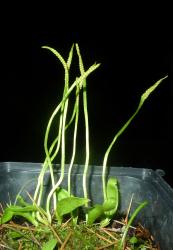Terrestrial (NZ) or sometimes epiphytic (not NZ) ferns. Rhizomes erect, glabrous; roots fleshy, not contractile, sometimes proliferous but lacking buds and gemmae. Fronds convolute, divided into a sterile photosynthetic blade and a reduced spore-bearing portion (sporophore), 1 or 2 produced per season. Common stalk glabrous or with occasional hairs. Sterile blade undivided, herbaceous or fleshy, glabrous or with occasional hairs. Veins reticulate. Sporophore undivided. Sporangia not in sori, deeply sunken in two rows on either side of the sporophore. Spores trilete, cream-white, coarsely to finely verrucate.
A genus of 30–50 species, depending on authority. Brownsey et al. (1985) noted that "Ophioglossum is a taxonomically difficult genus in which satisfactory characters are largely absent and species limits more than usually open to different interpretations by different workers". Despite earlier attempts by Clausen (1938) and Wieffering (1964) to revise the group, a modern monograph is still required. Brownsey et al. (1985) summarised understanding of the New Zealand species, but little progress has been made since then, and their conclusions are followed here.
Wagner (1990) recognised three subgenera in Ophioglossum – Ophioderma, Cheiroglossa and Ophioglossum. Cheiroglossa has a single epiphytic species in the New World tropics, Indo-China, Madagascar and Reunion, and is now often recognised at the generic level (e.g. Wagner & Wagner 1993). Ophioderma, with 1–4 epiphytic species, is confined to the Old World tropics. The majority of the species, including the two New Zealand species, are terrestrial and fall into subgenus Ophioglossum.
| 1 | Sterile blade of frond 0.5–14(20) mm wide, base attenuate to acuminate; veins often indistinct; sporophore with 3–17(20) pairs of sporangia | coriaceum |
| Sterile blade of frond (5)8–34 mm wide, base cuneate to truncate; veins usually distinct; sporophore with (13)18–48 pairs of sporangia | petiolatum |
Ophioglossum is recognised by its fronds which comprise an entire sterile blade with reticulate veins and an undivided sporophore. The sporangia are deeply sunken in the sporophore. By contrast, Botrychium has a dissected sterile blade with free veins and a branched sporophore with shortly stalked sporangia clustered on the branches. Species of Ophioglossum are unlike any other ferns in New Zealand in that the fronds unroll laterally from the centre rather than uncoiling lengthwise.
Cosmopolitan but with most species in the tropics (Wagner 1990). About eight species in temperate South America (Zuloaga et al. 2008), 15 in southern Africa (Crouch et al. 2011), seven in Australia (Chinnock 1998) and five or six in the Pacific. Two species in New Zealand; one endemic.
| Category | Number |
|---|---|
| Indigenous (Endemic) | 1 |
| Indigenous (Non-endemic) | 1 |
| Total | 2 |
The base chromosome number in Ophioglossum is x = 30 (Wagner 1990).
A single collection from "Gisborne", without collector or date (AK 58916), has been identified by M.P. Robinson (University of Adelaide, Australia) as "probably" the Australian species O. polyphyllum A.Braun. It is unclear whether the specimen is from Gisborne, New Zealand or Gisborne, near Melbourne, Australia, but a specimen of Asplenium hookerianum with the same locality and handwriting (AK 58913) suggests that they came from New Zealand because A. hookerianum is extremely rare in Australia. No other collection of O. polyphyllum is known from New Zealand, and Ophioglossum is rare in the entire Gisborne Ecological Province with only two collections of O. coriaceum having been made from Mt Hikurangi at high altitude. In Australia O. polyphyllum is widespread in arid areas (Chinnock 1998), and its occurrence in dry parts of the east coast of New Zealand is therefore possible. However, its presence needs confirmation and cannot be accepted on the basis of this specimen alone.




